Alyssa Flanders specializes in dermatology and aesthetic medicine. Many of you have already met her, whether for a skin check, acne treatment, or Botox and.CO₂ laser resurfacing. We are excited to celebrate her five year anniversary with us!
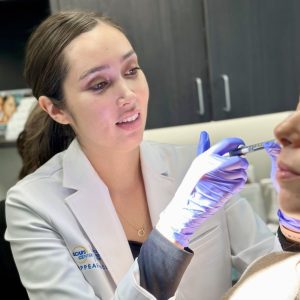
She is a graduate of Chapman University’s PA program, and is a nationally board certified physician assistant. Outside of clinical practice, she continues her involvement with Chapman’s PA program. She assists in interviews, dermatology lectures, and precepting students.
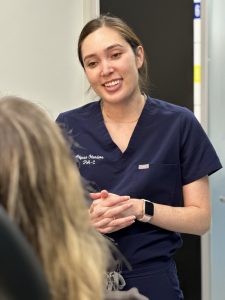
During her time at the Appearance Center and SCARS Center, she has been mentored by facial plastic surgeons, an oculoplastic surgeon, and both cosmetic and skin cancer dermatologists. She has confidently created her own unique practice by blending the expertise and mentorship of each specialty.
Alyssa is passionate about aesthetic medicine, primarily because it helps patients boost their self-confidence. She emphasizes foundational skin care and resurfacing that improves the overall skin quality and protects against both aging and skin cancers. She loves developing long-term relationships with her patients and helping them to look and feel their best.
Frank Ware is a patient who has benefitted from Dr. Madorsky’s skills twice! First, with a skin cancer reconstruction of his left cheek, and more recently with a “half facelift” on the right side of his face.
This patient exemplifies why we do what we do, embodying both the skin cancer and cosmetic goals of our practice.
Frank Ware came to the SCARS Center for surgical reconstruction of his left cheek post removal of melanoma. When Dr. Madorsky met Frank to treat his left cheek, he went right to the right side of his face, which has been paralyzed for decades due to a past surgical procedure. Years ago, Frank had an acoustic neuroma tumor in his cranial cavity, and when it was removed, the facial nerve was too involved to be saved. This resulted in facial paralysis. Frank has lived with this over the years, returning to his job as a middle school principal, and adapting to his strained speech and movement.
When Dr. Madorsky met and then examined Frank, he said, “I think we can do something about that.” He thought Frank would be a great candidate for a deep plane frace lift, well, at least half of one.
This brings up a very exciting parallel: The deep plane facelift technique used to correct the right-sided facial paralysis is what has driven development of the specialized flap (SMAS fasciocutaneous Island flap) used for the reconstruction of the melanoma of his left cheek.
In essence, the innovations in facial plastic surgery driven by cosmetic results also inform the methods for reconstruction of an area afflicted with skin cancer.
You glance in the mirror and notice the skin around your eyes looks a bit tired or droopy—maybe it’s time to consider a cosmetic procedure. But which one will help you look more refreshed: a blepharoplasty (eyelid lift) or a brow lift?
While both procedures focus on rejuvenating the eye area, they do so in different ways. Let’s take a closer look.
Blepharoplasty: Eyelid Surgery
Blepharoplasty targets the skin around the eyes and comes in two main types:
- Upper Eyelid Blepharoplasty: Removes excess skin and sometimes fat from the upper eyelid.
- Lower Eyelid Blepharoplasty: Addresses puffiness and under-eye bags by removing or repositioning fat and tightening loose skin beneath the eyes.

While this procedure can improve some dark circles, it won’t affect those caused by pigmentation or fine lines like crow’s feet. However, these issues can be treated with complementary options such as laser resurfacing, Botox, or fillers.
Brow Lift: Forehead Rejuvenation
As the name suggests, a brow lift works on the upper face—specifically the forehead and brows.
During the procedure, small incisions are typically made near the hairline. From there, tissue, skin, and muscle can be lifted to smooth forehead wrinkles, soften frown lines, and elevate drooping eyebrows.
This creates a more youthful, open look around the eyes. However, a brow lift does not remove excess eyelid skin—though it may improve the appearance of upper eyelid puffiness by lifting the brow itself. Surgery usually takes 1–2 hours and is often paired with other cosmetic enhancements like a facelift, blepharoplasty, or skin resurfacing.

Can You Combine These Procedures??
Yes, blepharoplasty and brow lift procedures can absolutely be combined, and in many cases, doing both provides the most balanced, natural-looking rejuvenation of the upper face.
While each procedure addresses specific issues, combining them can offer more comprehensive results. Sometimes what appears to be excess eyelid skin is actually the result of a sagging brow. In these cases, a brow lift alone might reduce the heaviness. But if there’s still extra skin or puffiness on the eyelids, a blepharoplasty may be needed as well.
Benefits of Combining Both Procedures
-
More dramatic, yet natural-looking results
-
Improved balance between the forehead, brow, and eyelids
-
Single recovery period instead of two separate surgeries
Dr. Jane Kim, a board-certified oculoplastic surgeon, will assess your facial anatomy and goals to determine which procedures are best for you.
Just like any valuable investment, your skin deserves regular care to stay beautiful and natural for years to come. That’s where we come in. Brooke McGuckin is our Aesthetic Nurse with a lifelong passion for skin health and aesthetics. She has spent over six years in the field of dermatology, where her love for skin health and patient care truly flourished.
With a unique blend of clinical experience and artistic eye, Brooke specializes in both aesthetic treatments and surgical nursing.
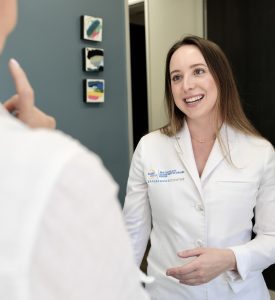
What sets Brooke apart is her passion for being a part of her patients’ full skin journey. From the very first consultation to surgery and follow-up appointments, Brooke is there every step of the way. She finds immense fulfillment in managing patient care and helping them maintain healthy, radiant skin.
“My goal is to enhance each patient’s appearance and confidence. I want to help them feel empowered and happy in the skin they’re in, and to know how to maintain their results.”
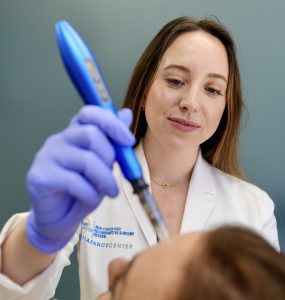
BROOKE SPECIALIZES IN
- Injectables (Botox & Filler, Facial Balancing)
- CO2 Laser Resurfacing
- Microneedling
- Vbeam Laser Treatment
- Chemical Peels – VI Peel & TCA Peel
- Hydrafacial
- Skincare / Product Recommendations
All of these procedures are performed in the office, with minimal or no pain, and a quick recovery.
Many people consider rhinoplasty because they want to smooth out a bump on the bridge of their nose or change its overall shape.
The “Old Way” vs. a “Newer Approach” to Nose Reshaping
Traditional Method: Think of the traditional way like sculpting from the top. To reduce a bump or lower the bridge, surgeons would remove bone and cartilage directly from the top of your nasal bridge. While this can fix the bump, it can sometimes change the natural lines of your nose quite a bit, and there’s a risk it might look a little “done” or unnatural.
Dorsal Preservation Rhinoplasty (The Newer Approach): This is what we’re excited about! “Dorsal” just refers to the bridge of your nose. “Preservation” means we try to keep its natural structure and lines as much as possible.
How it’s Different: Instead of removing bone and cartilage from the top of the bridge, the surgeon makes changes from underneath. Imagine carefully lowering the entire bridge structure from below, rather than chiseling away at the surface. This helps keep the original smooth lines of your nose intact.
The Goal: To give you the results you want (like removing a bump) while respecting and maintaining your nose’s unique, natural appearance.

Why Patients Often Prefer This Preservation Technique
The results with dorsal preservation rhinoplasty tend to make patients happier, which means it’s less likely you’d need a follow-up surgery (revision rhinoplasty). Here’s why:
- Keeps Your Nose Looking Naturally Yours: It helps maintain the natural width and smooth contours of your nasal bridge.
- Better for Straightening a Crooked Nose: It can lead to improved symmetry if your nose is a bit crooked.
- Less Reconstruction Needed: Your surgeon usually needs less cartilage to rebuild or support the nose.
In short, dorsal preservation rhinoplasty is an advanced technique that aims to correct issues like a nasal bump while ensuring your nose still looks like your nose, fitting naturally with your face. It’s about refining, not completely rebuilding, to achieve a look you’ll love.
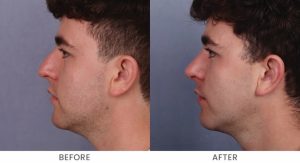
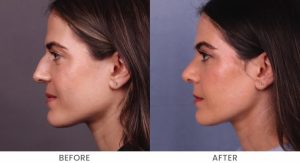
How do you achieve a more youthful face if you are not ready for or interested in a facelift? Can you get great results without a facelift? We say, “Absolutely.” Short of a facelift, we recommend three effective procedures for a more youthful, refreshed look.
BLEPHAROPLASTY
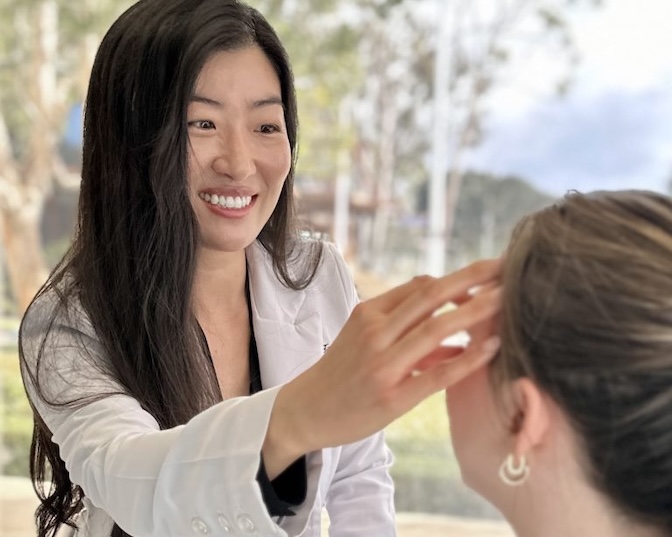
Blepharoplasty is a surgical procedure that improves the appearance of your eyelids. It helps reduce the look of tired eyes from your lower lids and removes drooping skin from your upper lids. You can focus on just the upper or lower lids, or address both at the same time.
CO2 LASER RESURFACING
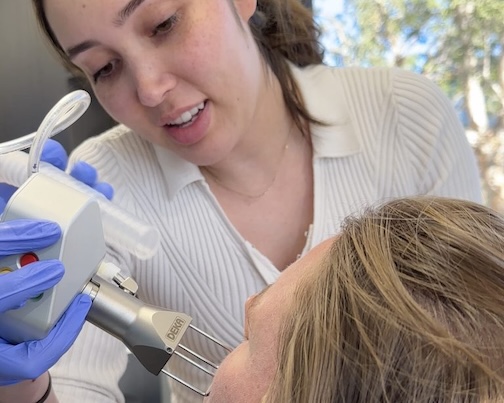
CO2 laser treatment aims to improve the appearance of the skin by removing the top layer and stimulating the formation of new skin cells. CO2 Laser Resurfacing is used to tighten the skin and to treat fine lines. It also treats wrinkles, sun-damaged skin, and scarring.
FAT TRANSFER
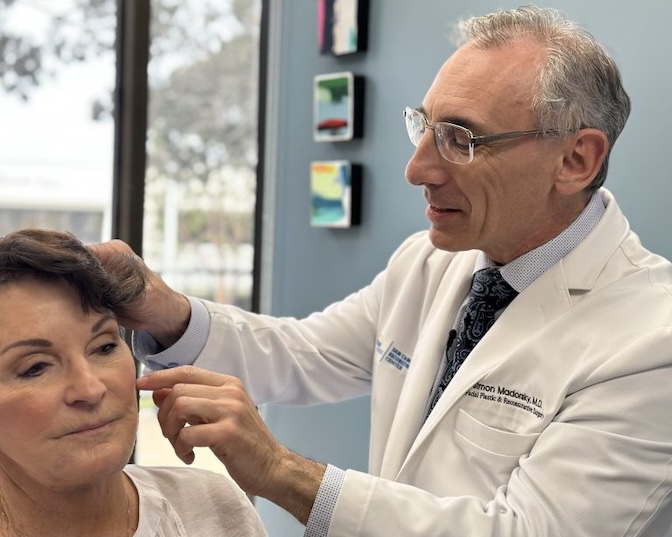
Facial fat transfer uses a person’s own existing body fat to restore volume to and plump sunken or sagging areas of the face. This procedure is used to treat deep creases on the forehead or between the eyebrows as well as hollow areas under the cheeks and eyes. It can also aid with contouring around the nose, temples, upper lip and the jaw.
Each of these procedures requires confirmation that you are a candidate, as well as some downtime.
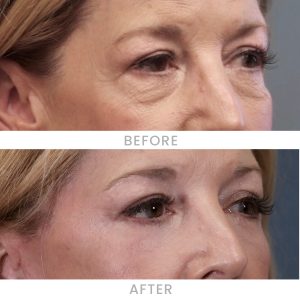
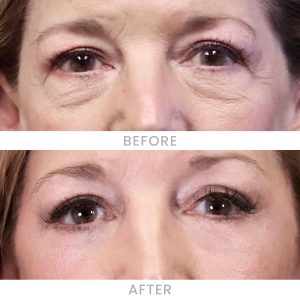
This patient had all three of these procedures: lower eyelid surgery with fat grafting and CO2 laser resurfacing of the skin around the eyelids.
When Should You Choose a Facelift?
While we have described some effective procedures for facial rejuvenation, sometimes these methods don’t do the trick.
Maybe you have tried injectables and chemical peels for a while, and they do not provide the long-term results you want. Or perhaps laser or radio frequency treatments just are not achieving what you want.
Whatever the reason, facelift surgery can achieve results that non-surgical results cannot match. Facelift surgery can reposition and lift facial tissues, which is something non-surgical options cannot replicate. It can also remove excess skin, which can roll back the clock on the face by years.
The chin plays a critical role in the balance of facial features. A strong chin can create a greater appearance of strength, symmetry and self-confidence. We offer several options to enhance the size and appearance of your chin.
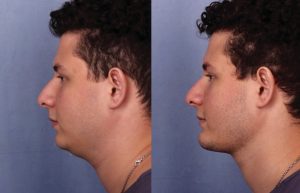
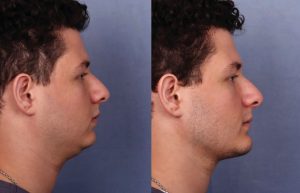
WHAT IS A CHIN IMPLANT?
Placement of a chin implant, also known as chin augmentation, provides definition for the lower face and balances the facial profile. Chin implants are made of various biocompatible materials and are custom-shaped for a natural looking fit. The results are permanent but can be reversed if desired.
Chin implants are used to correct a weak chin or to balance a strong nose. Patients who undergo chin augmentation love their results!
MALE CHIN AUGMENTATION
Male chin augmentation can redefine a jawline and strengthen the chin, creating facial harmony. A sharp, powerful chin is often considered the cornerstone of masculinity. Chin augmentation is a safe and effective way to restore what has been lost or enhance the current appearance.

CHIN IMPLANT & NECK LIPOSUCTION
Patients with excess fullness beneath the chin often choose to have neck liposuction at the same time as chin implant surgery. While strengthening the chin will help improve jawline definition on its own, removing excess fat from underneath the chin can further improve the appearance of the lower face and neck.
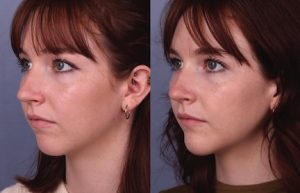
NONSURGICAL SOLUTION: INJECTABLES
Augmentation with filler is a great alternative for those who prefer nonsurgical treatment options, or who want to get a glimpse into how a chin augmentation would look.
We are pleased to announce that Dr. Madorsky’s article on the interaction between bone and chin implants has been published in Plastic and Reconstructive Surgery Global.
This research provides significant insights into the science of chin augmentation, notably by dispelling the misconception that implants cause bone erosion. The article decodes the complexities of implant-periosteum interaction and offers valuable guidance for improved chin implant procedures.
Background:
Bone resorption has been imputed to silicone chin implants as the cause of the reported bone changes with chin augmentation. Bone remodeling is complex. Both neo-ossification and bone resorption can occur.
Methods:
A literature review was performed on bone complications of silicone chin implants and bone remodeling with periosteal manipulation. Available data from plastic surgical and dental literature, alongside a case observation showing neo-ossification 10 years after implantation, were analyzed and used to explain patterns of bone changes around chin implants.
Results:
Periosteal elevation induces bone formation. Spur-like neo-ossification with silicone chin implants is caused by subperiosteal implant placement. Our case describes such neo-ossification 10 years after silicone chin implantation. The pressure of an implant on bone can cause limited bone resorption. The pressure of an implant trapped under a forming bone shelf can cause significant bone resorption in rare cases.
Conclusions:
Previously reported mandibular bone resorption ascribed to silicone chin implants has been overwrought. Bone formation is more common with silicone chin augmentation. We propose surgical modifications to limit bone complications of chin implants based on the reviewed literature. Surgical approaches to periosteal elevation and implant insertion and consideration of alternate biomaterials to silicone chin implants may improve outcomes of chin augmentation.
We are excited to announce that The Appearance Center now offers Sylfirm X, a minimally-invasive radiofrequency (RF) treatment that is safe and effective on all skin types.
What is Sylfirm X?
Sylfirm X improves both skin texture (fine lines, scarring) and skin tone (brown spots and redness).
It is the first and only FDA approved RF microneedling device featuring dual wave settings. One setting increases collagen production treating skin wrinkles or acne scarring. Another setting evens out redness and dark spots associated with sun damage.
Amazingly, it does all this with minimal pain and downtime. Downtime typically involves 1 day of redness.
Sylfirm X is effective in treating a variety of skin issues, including:
-
Fine lines
-
Wrinkles
-
Skin laxity
-
Acne scars and other types of scarring
-
Stretch marks
-
Hyperpigmentation
-
Enlarged pores
-
Mild to moderate sagging skin
-
Skin redness
-
Vascular issues like rosacea


How it Works
Sylfirm X uses microneedles and radiofrequency technology to transmit thermal energy deep into the skin. This system administers an accurate amount of energy at a specific depth during the treatment. Unlike other devices, Sylfirm X reacts ONLY to abnormal blood vessels and tissue to selectively treat increased pigmentation and vascular lesions. It is the only RF microneedling device approved for hard-to-treat conditions like rosacea and melasma.
Who is a Good Candidate?
Sylfirm X is safe on all skin types, including darker skin tones. The best candidates are healthy patients with mild to moderate skin laxity, fine lines, stretch marks, acne scars, and/or pigmentation concerns.
How Long Do Results Last?
You can see significant improvement with three sessions. Because it is a collagen producing treatment, the results do not “wear off” after any amount of time.
Obvious results are normally seen after just one treatment. However, to help achieve the maximum benefit, a three-treatment series is suggested, with each treatment four to six weeks apart.
“A Mommy Makeover is just a Breast Augmentation and Tummy Tuck, right?”
Not according to Dr. Suzanne Quardt (aka Dr Q). That is a limiting definition of what this life-changing transformation can include. In Dr. Quardt’s practice, a Mommy Makeover is any combination of procedures that a woman and her plastic surgeon deem beneficial to make her look and feel her best. There is no set formula, but more of a “mixing and matching” of specific procedures tailored to achieve each patient’s desired results for this new stage in her life.
Dr. Quardt guides each patient through the process, educating them on their options, what is realistic and best for them, and how to best prepare for and recover from their procedures.
“It is so rewarding for me, as a female surgeon and mother, to help women to look and feel their best after the wonderful, life-changing (yet body-altering) event of becoming a mother.”
Mommy Makeovers can include any combination of a wide range of procedures such as the following:
- Breast Augmentation – with implants, or through fat transfer
- Breast Lift – to create perky breasts by removing excess skin, or to enhance breast shape and breast size along with implants
- Breast Reduction – to reduce overly large breasts and also create a lift
- Liposuction – to the abdomen, hips, thighs, back in order to create a waistline and contour the body
- Tummy Tuck or Mini Tummy Tuck – to remove excess skin and fat and flatten the underlying abdominal muscles (often combined with liposuction)
- Labiaplasty – to reduce redundant outer lip skin/tissue
Pregnancy, childbirth and breastfeeding certainly change a woman’s body, but the Mommy Makeover isn’t about “restoring a pre-pregnancy body” per se. It is more about determining a woman’s unique needs and goals moving forward, and establishing a road map with the advice and expertise of her surgeon to attain the optimal body aesthetic for each woman’s unique stage in their lives.
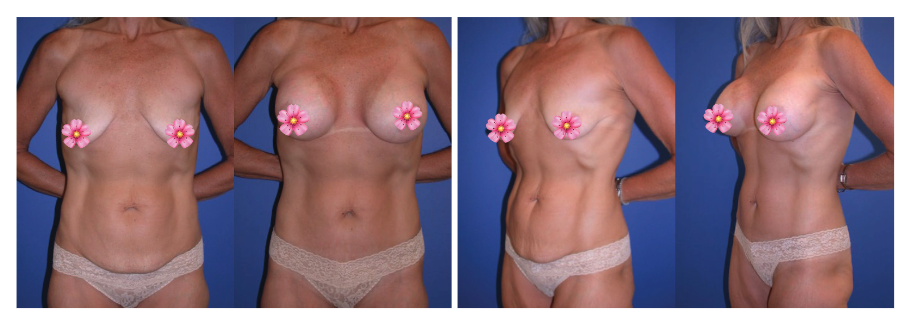
This 49-year-old mother complained of loss of fullness of her breasts after having one child and breastfeeding. She was very fit, but didn’t like a small flap of skin on her lower abdomen. She underwent a Breast Augmentation with Silicone Gel Implants as well as Mini Tummy Tuck.
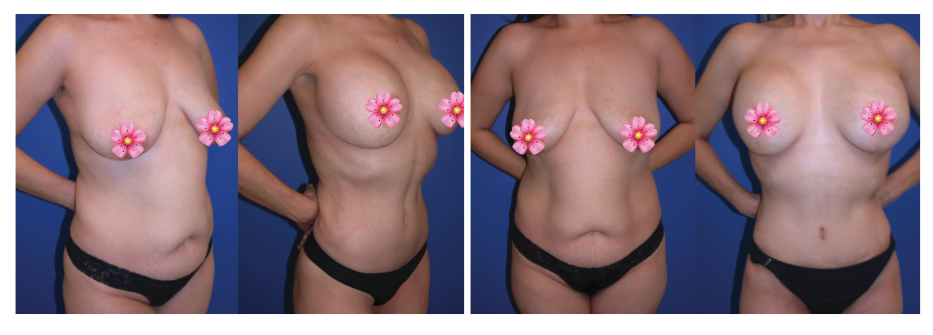
This 30-year-old mother of one lost about 80 pounds after her pregnancy. She desired fuller breasts and a flat tummy. She underwent a Breast Augmentation using “Gummy Bear” Implants, a Tummy-Tuck, and Liposuction of her torso.
